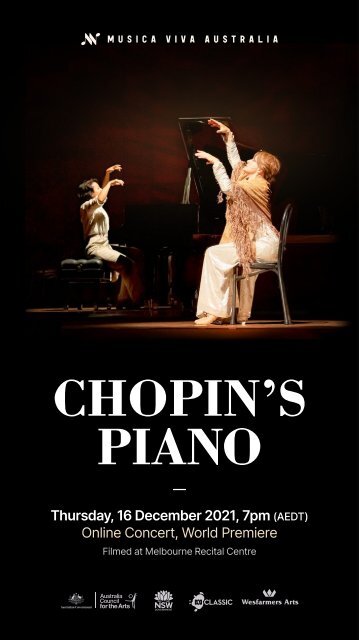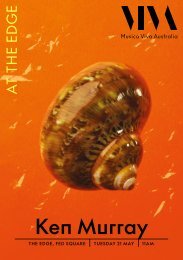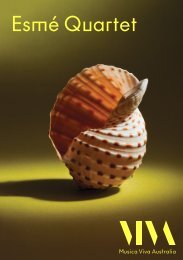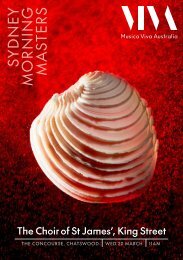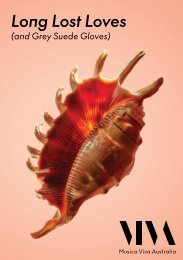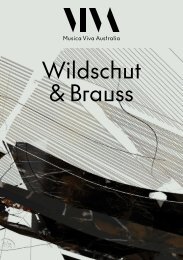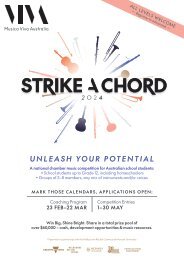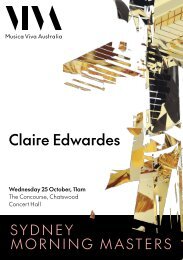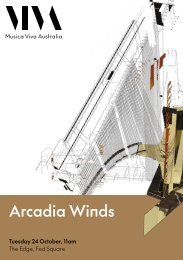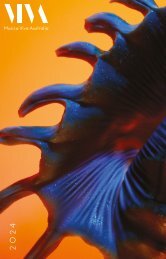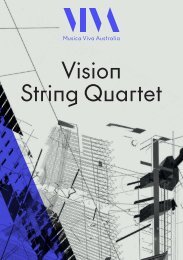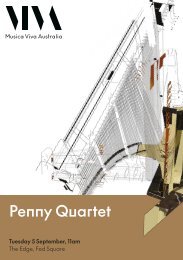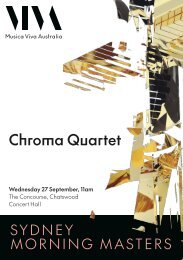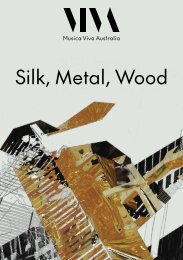Create successful ePaper yourself
Turn your PDF publications into a flip-book with our unique Google optimized e-Paper software.
CHOPIN’S<br />
PIANO<br />
—<br />
Thursday, 16 <strong>December</strong> <strong>2021</strong>, 7pm (AEDT)<br />
Online Concert, World Premiere<br />
Filmed at Melbourne Recital Centre
Tickets on sale now<br />
musicaviva.net.au
Musica Viva Australia acknowledges the<br />
Traditional Custodians of the many lands on which we<br />
meet, work and live, and we pay our respects to Elders<br />
past and present – people who have sung<br />
their songs, danced their dances and told their stories<br />
on these lands for thousands of generations,<br />
and who continue to do so.<br />
3
4
Chopin's <strong>Piano</strong><br />
Written by Paul Kildea and Richard Pyros<br />
Adapted from the book by Paul Kildea,<br />
Chopin’s <strong>Piano</strong>: A Journey through Romanticism<br />
Director<br />
Lighting Designer<br />
Costume & Set Designer<br />
Sound Designer<br />
Stage Manager<br />
Producer<br />
Associate Lighting Design<br />
Costume Supervisor<br />
Costume Makers<br />
Film Production<br />
Film Direction<br />
Production Sound Mixer<br />
Richard Pyros<br />
Richard Vabre<br />
Christina Smith<br />
Kelly Ryall<br />
Annie Halliday<br />
Janelle McKenzie<br />
Tom Willis<br />
Isaac Lummis<br />
Janice Chalmers<br />
Melinda Brodie<br />
Susan Skinner<br />
Cloakroom Media<br />
Richard Pyros<br />
Mark Edwards<br />
5
Act One<br />
Aura Go<br />
piano, Frédéric Chopin<br />
Susan Prior<br />
Juan Bauza, George Sand, Franz Liszt, Eugène Delacroix<br />
Act Two<br />
Aura Go<br />
piano, Alexander Binder, Henri Lew, Constantin Brâncuși,<br />
Denise Restout, Nazi Officer, US Immigration Officer<br />
Susan Prior<br />
Wanda Landowska, Peggy Guggenheim,<br />
Nazi Officer, Juan Bauza<br />
Aura Go<br />
Susan Prior<br />
6
7
Frédéric CHOPIN (1810–1849)<br />
24 Preludes, Op. 28 (1835–39)<br />
45 minutes<br />
I<br />
II<br />
III<br />
IV<br />
V<br />
VI<br />
VII<br />
VIII<br />
IX<br />
X<br />
XI<br />
XII<br />
XIII<br />
XIV<br />
XV<br />
XVI<br />
XVII<br />
XVIII<br />
XIX<br />
XX<br />
XXI<br />
XXII<br />
XXIII<br />
XXIV<br />
Agitato (C major)<br />
Lento (A minor)<br />
Vivace (G major)<br />
Largo (E minor)<br />
Molto allegro (D major)<br />
Lento assai (B minor)<br />
Andantino (A major)<br />
Molto agitato (F-sharp minor)<br />
Largo (E major)<br />
Molto allegro (C-sharp minor)<br />
Vivace (B major)<br />
Presto (G-sharp minor)<br />
Lento (F-sharp major)<br />
Allegro (E-flat minor)<br />
Sostenuto (D-flat major)<br />
Presto con fuoco (B-flat minor)<br />
Allegretto (A-flat major)<br />
Molto allegro (F minor)<br />
Vivace (E-flat major)<br />
Largo (C minor)<br />
Cantabile (B-flat major)<br />
Molto agitato (G minor)<br />
Moderato (F major)<br />
Allegro appassionato (D minor)<br />
8
Recordings<br />
Frédéric CHOPIN (1810–1849)<br />
Prelude No. 6, Op. 28 (1835–39)<br />
Performed by: Gunther Rost<br />
Johann Sebastian BACH (1685–1750)<br />
Prelude in F-sharp major, BWV 858 (1722)<br />
Domenico SCARLATTI (1685–1757)<br />
Keyboard Sonata in D major, K. 490 (pub. 1804)<br />
Performed by: Wanda Landowska<br />
Johann Sebastian BACH (1685–1750)<br />
Goldberg Variations, BWV 988 (1741)<br />
Performed by: Wanda Landowska<br />
Johann Sebastian BACH (1685–1750)<br />
Prelude No. 11 in F major, BWV 880 (1740)<br />
Performed by: Wanda Landowska<br />
9
The characters<br />
Most music lovers will be familiar with Chopin and his beloved<br />
Preludes, but perhaps less well-acquainted with the colourful cast<br />
of characters that populated his life at the time of composition.<br />
Here’s a cheat sheet that will help get you up to speed, with an<br />
introduction to those who figure in the later history of the piano<br />
on which Chopin composed his enduring masterpiece. Together,<br />
they form the shining, complex tapestry woven by Chopin’s <strong>Piano</strong>,<br />
Musica Viva Australia’s semi-staged production adapted from<br />
Artistic Director Paul Kildea’s book of the same name.<br />
Juan Bauza<br />
The story of Chopin’s <strong>Piano</strong> begins with Juan Bauza, the local<br />
Majorcan craftsman who fashioned the instrument that Chopin<br />
would hire to finish composing his 24 Preludes. At the time,<br />
Majorcans had little exposure to the development of the pianoforte,<br />
which was becoming incredibly popular in mainland Europe in the<br />
1820s and 30s. This meant that Bauza’s piano was a fairly primitive<br />
instrument in comparison, but it certainly didn’t stop Chopin from<br />
producing some of his very best work. Little else is known about<br />
Bauza, but his role in musical history is obviously significant.<br />
George Sand<br />
Born Amantine Lucile Aurore Dupin, George<br />
Sand was the most well-known female French<br />
novelist of the 19 th century. A fascinating,<br />
colourful fixture of Parisian life, she was also a<br />
noted memoirist and journalist, with forays into<br />
the theatre and political sphere, as well as an<br />
accomplished draughtsperson and painter. She<br />
garnered a slightly dubious reputation based in<br />
part on the subject matter of her fiction, which<br />
dealt with sexuality, incest, and relationships<br />
10
etween the classes. That reputation was exacerbated by<br />
her affairs with the well-known figures of her day and her long<br />
relationship with Chopin. In fact, Sand accompanied him on that<br />
fateful trip to Majorca with her children, and their relationship was<br />
by many accounts artistically collaborative, each supporting the<br />
other in their endeavours. They separated two years before his<br />
death.<br />
Franz Liszt<br />
Born in Hungary on October 22, 1811, Franz<br />
Liszt was a composer and pianist of astonishing<br />
virtuosity. Acknowledged as the first person<br />
to give complete solo recitals as a pianist<br />
(previously musicians had been expected to<br />
share concerts with other performers), he<br />
thrilled by performing from memory, playing<br />
almost the entire keyboard repertoire as it<br />
existed up to then, and drawing massive<br />
crowds that were more akin to rock shows.<br />
Liszt’s body of work is acknowledged for its originality, and for the<br />
way he extended harmonic language and anticipated the atonal<br />
music of the 20 th century. He became friends with Chopin after<br />
the latter’s arrival in Paris and was the dedicatee of Chopin’s Op 10<br />
Études.<br />
Eugène Delacroix<br />
Born in 1798, Eugène Delacroix was the<br />
foremost French painter of his day. Widely<br />
regarded as the leader of the Romantic<br />
movement in 19th century French art, his body<br />
of work is notable for their emotionally charged<br />
depictions of historical and contemporary<br />
events, as well as literary and “exotic” subjects.<br />
Delacroix was highly influenced by the great<br />
colourist painters of the Venetian Renaissance,<br />
as well as his great idol, Rubens. Their influence<br />
11
can be detected in his trademark vivid use of colour and<br />
expressive brushwork. Perhaps his most recognisable work<br />
is Liberty Leading the People, which commemorates the July<br />
Revolution of 1830 which saw the overthrow of King Charles X of<br />
France. A friend of Chopin’s, one of his few portraits – unfinished –<br />
was of the composer and Sand. Later cut in two, they were sold off<br />
as separate pieces after Delacroix’s death.<br />
Wanda Landowska<br />
Born in Warsaw, Poland in 1879,<br />
Wanda Landowska was a noted<br />
harpsichordist and pianist whose<br />
work did much to revive interest<br />
in the harpsichord in the early<br />
20 th century. She studied in<br />
Warsaw, Berlin, and Paris, and by<br />
1912 was teaching harpsichord<br />
at the famed Berlin Hochschule<br />
für Musik. Her championing of<br />
the instrument saw composers<br />
such as Manuel de Falla and<br />
Francis Poulenc compose<br />
harpsichord works for her, and<br />
she was the first person to record Bach’s Goldberg Variations on<br />
harpsichord. She was a great admirer of Chopin and set out in<br />
1911 to Majorca in a pilgrimage to the monastery where Chopin<br />
composed his Preludes. It was there she found and acquired the<br />
Bauza piano, which she was forced to leave behind in Paris when<br />
the Nazis invaded in 1940. Her home was looted, and her collection<br />
of instruments, including the piano, were seized by the Nazis.<br />
Landowska meanwhile fled to New York, where she continued<br />
teaching and performing to acclaim. It was in July 1946 that the<br />
piano and her instruments were finally returned to her home in<br />
Paris. Landowska would never be reunited with them, remaining in<br />
America until her death in 1959.<br />
12
Henri Lew<br />
Henri Lew was a Polish folklorist and ethnomusicologist with whom<br />
Wanda Landowska eloped and then married in Paris in 1900. He<br />
was supportive of her work, and together they collaborated on<br />
the writing and publication of a book, La musique ancienne, which<br />
explored 17 th - and 18 th -century music and its interpretation. He was<br />
struck and killed by a car in 1919.<br />
Peggy Guggenheim<br />
Peggy Guggenheim was an American collector and gallerist born<br />
in New York in 1898. Involved in the mining and smelting industries,<br />
her family was one of the wealthiest in the city. As a way of<br />
distinguishing herself from her business-minded relations, she<br />
travelled the world collecting art. Among those she championed<br />
were Kandinsky, Pollock, and Tanguy, and she had a special<br />
taste for Surrealism. When Germany invaded France in 1940, she<br />
endeavoured to acquire as many important works as she could in<br />
the hope of keeping them from the Nazis.<br />
Constantin Brâncuși<br />
Constantin Brâncuși was a Romanian sculptor, painter and<br />
photographer who found fame in France. Considered one of the<br />
most important sculptors of the 20 th century, he distinguished<br />
himself from his peers by carving his work directly from wood or<br />
stone or casting from bronze.<br />
Denise Restout<br />
Denise Restout was a French keyboard teacher who also served<br />
as assistant, protégé, editor and biographer for Wanda Landowska.<br />
She began studying harpsichord with Landowska in 1933, and<br />
appeared at her public masterclasses in France, the Netherlands<br />
and Strasbourg. They fled France in 1940 during the Nazi advance<br />
on Paris and lived together in America until Landowska’s death<br />
in 1959. Restout inherited her estate, including her papers and<br />
instruments, and continued at teacher until her death in 2004.<br />
13
The creatives<br />
Richard Pyros<br />
Director, Film Director & Writer<br />
more info<br />
Paul Kildea<br />
Writer<br />
more info<br />
Richard Vabre<br />
Lighting Designer<br />
more info<br />
Christina Smith<br />
Costume & Set Designer<br />
more info<br />
Tom Willis<br />
Associate Lighting Designer<br />
more info<br />
Isaac Lummis<br />
Costume Supervisor<br />
more info<br />
Kelly Ryall<br />
Sound Designer<br />
more info<br />
Cloakroom Media<br />
Film Production<br />
more info<br />
Costume designs by Christina Smith<br />
14
Buy from Penguin<br />
15
16
For more information on Chopin's <strong>Piano</strong>,<br />
including Paul Kildea and Aura Go in conversation,<br />
please visit: musicaviva.com.au/chopins-piano-digital<br />
Ensemble Patrons<br />
Michele & Stephen Johns<br />
Anonymous<br />
Concert Champions<br />
Don & Veronica Aldridge<br />
Robert & Lindy Henderson<br />
Monica Lim & Konfir Kabo<br />
Dr Sue Packer<br />
Prichard Panizza Family<br />
The Hon Justice A Philippides<br />
Ray Turner & Jennifer Seabrook<br />
Kay Vernon<br />
Kim Williams AM & Catherine Dovey<br />
Musica Viva Australia and Richard Pyros would also like to thank<br />
Katherine Tonkin, Bakehouse Studios, Darebin Arts Centre,<br />
Malthouse Theatre, Melbourne Recital Centre, Ben McEwing,<br />
Robin Geradts-Gill and Valerie and Philip Pyros for their<br />
assistance as we have developed, rehearsed and re-imagined<br />
this production whilst grappling with all of the Covid-19<br />
twists and turns over the past 12 months.<br />
Production photography by James Grant.<br />
Additional images: Henri Lehmann (Liszt), Félix Nadar (Delacroix).<br />
17
Music brings us together<br />
At Musica Viva Australia we are proud to share exceptional music<br />
with audiences of every age, location and circumstance – it's<br />
what we have always done, and what we will always strive to do.<br />
With your contribution, we can support our professional<br />
musicians, introduce children to live music in schools,<br />
commission new works, create innovative and engaging online<br />
content, and develop future generations of artists.<br />
Scan the QR code to give today.<br />
Contact us on philanthropy@musicaviva.com.au


